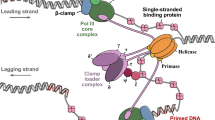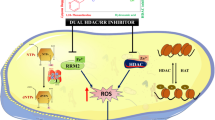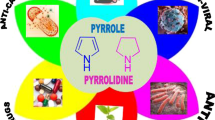Abstract—
Platinum complexes are among the most commonly prescribed drugs in cancer therapy but show significant toxicity to healthy tissues as a side effect. Platinum polyoxometalates are platinum complexes liganded with cluster anions consisting of oxygen atoms and transition metals. Their properties related to a potential use as anticancer drugs have never been studied. In this paper, we have investigated the effect of platinum (IV) polyoxoniobate of the [Nb6O19{Pt(OH)2}]2 structure containing two platinum centers and two polynuclear Lindqvist type anions on the activity of a number of DNA polymerases belonging to different families (Klenow fragment of Escherichia coli DNA polymerase I, bacteriophage RB69 DNA polymerase, human DNA polymerases β and κ, DNA polymerase IV from Sulfolobus solfataricus). On its own, platinum polyoxoniobate did not act as an inhibitor of DNA polymerases, but was capable of forming adducts with DNA.




Similar content being viewed by others
REFERENCES
Kelland, L., Nat. Rev. Cancer, 2007, vol. 7, pp. 573–584.
Florea, A.-M. and Büsselberg, D., Cancers, 2011, vol. 3, pp. 1351–1371.
Lawley, P.D. and Phillips, D.H., Mutat. Res., 1996, vol. 355, pp. 13–40.
Jamieson, E.R. and Lippard, S.J., Chem. Rev., 1999, vol. 99, pp. 2467–2498.
Wang, D. and Lippard, S.J., Nat. Rev. Drug Discov., 2005, vol. 4, pp. 307–320.
Dasari, S. and Tchounwou, P.B., Eur. J. Pharmacol., 2014, vol. 740, pp. 364–378.
Wheate, N.J., Walker, S., Craig, G.E., and Oun, R., Dalton Trans., 2010, vol. 39, pp. 8113–8127.
Apps, M.G., Choi, E.H.Y., and Wheate, N.J., Endocr. Relat. Cancer, 2015, vol. 22, pp. R219–R233.
Hu, X., Li, F., Noor, N., and Ling, D., Sci. Bull., 2017, vol. 62, pp. 589–596.
Li, X., Liu, Y., and Tian, H., Bioinorg. Chem. Appl., 2018, vol. 2018, p. 8 276 139.
Shigeta, S., Mori, S., Yamase, T., Yamamoto, N., and Yamamoto, N., Biomed. Pharmacother., 2006, vol. 60, pp. 211–219.
Yanagie, H., Ogata, A., Mitsui, S., Hisa, T., Yamase, T., and Eriguchi, M., Biomed. Pharmacother., 2006, vol. 60, pp. 349–352.
Stephan, H., Kubeil, M., Emmerling, F., and Müller, C.E., Eur. J. Inorg. Chem., 2013, vol. 2013, pp. 1585–1594.
Wang, S., Sun, W., Hu, Q., Yan, H., and Zeng, Y., Bioorg. Med. Chem. Lett., 2017, vol. 27, pp. 2357–2359.
Bijelic, A., Aureliano, M., and Rompel, A., Chem. Commun., 2018, vol. 54, pp. 1153–1169.
Bijelic, A., Aureliano, M., and Rompel, A., Angew. Chem., Int. Ed. Engl., 2019, vol. 58, pp. 2980–2999.
Sun, T., Cui, W., Yan, M., Qin, G., Guo, W., Gu, H., Liu, S., and Wu, Q., Adv. Mater., 2016, vol. 28, pp. 7397–7404.
Abramov, P.A., Vicent, C., Kompankov, N.B., Gushchin, A.L., and Sokolov, M.N., Chem. Commun., 2015, vol. 51, pp. 4021–4023.
Inouye, Y., Tokutake, Y., Kunihara, J., Yoshida, T., Yamase, T., Nakata, A., and Nakamura, S., Chem. Pharm. Bull., 1992, vol. 40, pp. 805–807.
Sarafianos, S.G., Kortz, U., Pope, M.T., and Modak, M.J., Biochem. J., 1996, vol. 319, pp. 619–626.
Schoeberl, C., Boehner, R., Krebs, B., Mueller, C., and Barnekow, A., Int. J. Oncol., 1998, vol. 12, pp. 153–159.
Steitz, T.A., J. Biol. Chem., 1999, vol. 274, pp. 17 395–17 398.
Torres, M.C., Varaprasad, C.V., Johnson, F., and Iden, C.R., Carcinogenesis, 1999, vol. 20, pp. 167–172.
Wang, X., Liu, J., Li, J., Yang, Y., Liu, J., Li, B., and Pope, M.T., J. Inorg. Biochem., 2003, vol. 94, pp. 279–284.
Dianat, S., Bordbar, A.K., Tangestaninejad, S., Yadollahi, B., Zarkesh-Esfahani, S.H., and Habibi, P., J. Photochem. Photobiol., vol. 124, pp. 27–33.
Ohashi, E., Ogi, T., Kusumoto, R., Iwai, S., Masutani, C., Hanaoka, F., and Ohmori, H., Genes Dev., 2000, vol. 14, pp. 1589–1594.
Freisinger, E., Grollman, A.P., Miller, H., and Kisker, C., EMBO J., 2004, vol. 23, pp. 1494–1505.
Sambrook, J. and Russell, D.W., Molecular Cloning: A Laboratory Manual, Cold Spring Harbor, New York: Cold Spring Harbor Laboratory Press, 2001.
Funding
This study was supported by the Russian Foundation for Basic Research (project no. 19-44-543011-r_mol_a), Novosibirsk region, and partially by a project of Basic Funding from the Program for Fundamental Scientific Research of State Science Academies for 2013–2020 No. АААА-А17-117020210023-1 (synthesis of oligonucleotides, extraction of a part of proteins) and the Ministry of Higher Education and Science of the Russian Federation (project 6.5773.2017/VU, data analysis).
Author information
Authors and Affiliations
Corresponding author
Ethics declarations
This article does not contain any studies involving animals or human participants performed by any of the authors.
Conflict of Interests
Authors declare that they have no conflicts of interests.
Additional information
Translated by M. Novikova
Abbreviations: DTT, dithiothreitol; EDTA, ethylenediaminetetraacetic acid; KF, Klenow fragment of Escherichia coli DNA polymerase I; ODN, oligodeoxyribonucleotide; Pt-PON, platinum polyoxoniobate.
Corresponding author: phone: +7 (383) 363-51-87; fax: +7 (383) 363-51-53; e-mail: dzharkov@niboch.nsc.ru.
Rights and permissions
About this article
Cite this article
Yudkina, A., Sokolov, M., Abramov, P. et al. Platinum Polyoxoniobates Form Adducts with DNA. Russ J Bioorg Chem 45, 641–646 (2019). https://doi.org/10.1134/S1068162019060414
Received:
Revised:
Accepted:
Published:
Issue Date:
DOI: https://doi.org/10.1134/S1068162019060414




